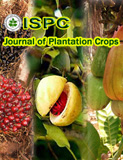Comparative biochemical features of wild-type and purple cashew (Anacardium occidentale L.)
DOI:
https://doi.org/10.25081/jpc.2024.v52.i1.9176Abstract
The comparative biochemical features of both the wild-type and purple-coloured cashew apple varieties are presented. The total soluble sugar content in purple cashew apples was higher (13.96%) than that in normal cashew apples (6.78%). Compared with purple cashews, wild-type cashew apples have a high titratable acidity (0.224%) as they contain more ascorbic acid (342.85 mg/100 g) than purple cashew apples (228.57 mg/100 g). The total polyphenol content of purple fruit leaves (8.04 mg GAE/g), peels (4.532 mg GAE/g), and pulp (2.067 mg GAE/g) was higher than that of wild-type cashews. Additionally, the flavonoid content (9.423 mg/g in leaves, 4.923 mg/g in apple peels, and 3.688 mg/g in cashew pulp) was higher in the purple cashew than in the wild-type cashews. Chlorophyll a, b, and total chlorophyll contents in wild-type cashew leaves (0.287 mg/g, 0.176 mg/g, and 0.463 mg/g, respectively) were greater than those in purple cashew leaves. However, the chlorophyll concentration in the fruit was found to be very minimal. Although the carotenoid content of the fruit was high in the wild-type cashew (22.83 g/100 g), the carotenoid concentration in the purple cashew leaves (83.475 g/100 g) was greater than that in the normal cashew leaves. Analysis of the anthocyanin contents suggested that the leaves and peels of plants with the purple genotype had relatively high anthocyanin contents (38.499 mg cyanidin-3-glucoside equivalents/kg (C3GE/kg) and 25.87 mg C3GE/kg) compared to those of plants with the wild-type cashews (0.157 and 0.951 mg C3GE/kg, respectively). These biochemical constituents of purple cashew suggest its potential application in the development of cashew apple-based nutritional products.
Downloads
References
Anand, A., Sahu, G. S., & Mishra, N. 2015. Physico-chemical Characteristics of Cashew. Research Journal of Agricultural Sciences, 6(3): 656-658.
Assuncao, R.B., Mercadante, A.Z.2003. Carotenoids and ascorbic acid from cashew apple (Anacardium occidentale L.): variety and geographic effects. Food Chemistry, 81 (4): 495–502.
Benzie, I.F. and Strain, J.J., 1996. The ferric reducing ability of plasma (FRAP) as a measure of “antioxidant power”: the FRAP assay. Analytical Biochemistry, 239(1): 70-76.
Brand-Williams, W., Cuvelier, M.E. and Berset, C.L.W.T., 1995. Use of a free radical method to evaluate antioxidant activity. LWT-Food science and Technology, 28(1): 25-30.
DuBois, M., Gilles, K.A., Hamilton, J.K., Rebers, P.T. and Smith, F., 1956. Colorimetric method for determination of sugars and related substances. Analytical chemistry, 28(3):350-356.
Gordon, A., Friedrich, M., Da Matta, V.M., Moura, C.F.H. and Marx, F., 2012. Changes in phenolic composition, ascorbic acid and antioxidant capacity in cashew apple (Anacardium occidentale L.) during ripening. Fruits, 67(4):267-276.
Jeyavishnu, K., Thulasidharan, D., Shereen, M.F. and Arumugam, A., 2021. Increased revenue with high value-added products from cashew apple (Anacardium occidentale L.) - addressing global challenges. Food and Bioprocess Technology, 14: 985-1012.
Kalt, W., Forney, C.F., Martin, A., & Prior, R.L. 1999. Antioxidant capacity, vitamin C, phenolics, and anthocyanins after fresh storage of small fruits. Journal of Agricultural and Food Chemistry, 47(11): 4638-4644.
Lee, J., Durst, R.W., Wrolstad, R.E., & Collaborators: Eisele T Giusti MM Hach J Hofsommer H Koswig S Krueger DA Kupina; S Martin SK Martinsen BK Miller TC Paquette F Ryabkova A Skrede G Trenn U Wightman JD. 2005. Determination of total monomeric anthocyanin pigment content of fruit juices, beverages, natural colorants, and wines by the pH differential method: collaborative study. Journal of AOAC international, 88(5): 1269-1278.
Lichtenthaler, H.K.1987. Chlorophyll and carotenoids, the pigments of photosynthetic bio membranes. Methods Enzymol. 148: 350- 382.
Oliveira, N.N., Mothé, C.G., Mothé, M.G. and de Oliveira, L.G., 2020. Cashew nut and cashew apple: a scientific and technological monitoring worldwide review. Journal of Food Science and Technology, 57:12-21.
Rao, K.U., Kumar, B.P., Swami, D.V., Sunnetha, B.S., Krishna, K.U. and Smith, D.D., 2020. Standardisation of RTS beverage from reconstituted cashew apple-based blended juice powder along with Sugandi. Journal of Plantation Crops, 49(1):42-55.
Schweiggert RM, Vargas E, Conrad J, Hempel J et al., 2016. Carotenoids, carotenoid esters, and anthocyanins of yellow-, orange, and red-peeled cashew apples (Anacardium occidentale L.). Food Chemistry 200:274–282.
Singleton, V.L., Orthofer, R. and Lamuela-Raventós, R.M., 1999. Analysis of total phenols and other oxidation substrates and antioxidants by means of folin-ciocalteu reagent. In Methods in enzymology (Vol. 299, pp. 152-178). Academic press.
Somogyi, M., 1952. Notes on sugar determination. Journal of Biological Chemistry, 195:19-23.
Veena, G.L., Adiga, J.D., Mohana, G.S., Eradasappa, E., Savadi, S., Vanitha, K., Thondaiman, V. and Shamsudheen, M., 2023. Purple Cashew (Anacardium occidentale L.): a Unique Cashew Type. National Academy Science Letters 46(6): 559-562.
Zhishen, J., Mengcheng, T. and Jianming, W., 1999. The determination of flavonoid contents in mulberry and their scavenging effects on superoxide radicals. Food Chemistry, 64(4):555-559.
Published
How to Cite
Issue
Section
Copyright (c) 2024 Journal of Plantation Crops

This work is licensed under a Creative Commons Attribution 4.0 International License.







 .
.